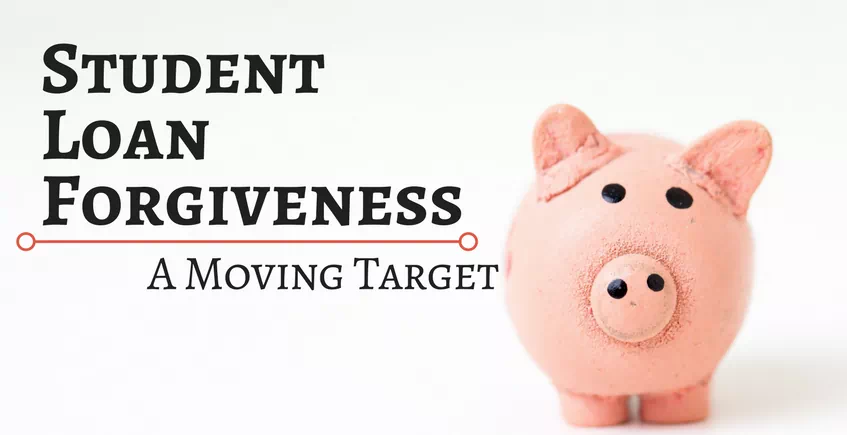A recent poll by LendEDU offered the surprising statistic that almost half of the current loan-holding college students believe their college loans will be forgiven. In addition to the mystery of this statistic is the fact that no one has delved into why the students believe their loans will be forgiven. Despite recent campaign rhetoric, no new loan forgiveness options have been put in place leaving the existing options as the only avenues available. Given the rigidity and complexity of these existing options, this seems like an ideal reason to engage borrowing students with a conversation regarding future loan forgiveness.
Public Service Loan Forgiveness
It is a fair guess that most students believe their loans will be forgiven by exercising the Public Service Loan Forgiveness. Starting back in 2007, the initiative was launched allowing borrowers meeting specific criteria to have the remaining balance on their loans forgiven. Borrowers seeking Public Service Loan Forgiveness must have made 120 full and on-time payments towards the existing loans while being employed by an organization which falls under the areas mentioned in the initiative. However, as profiled in the New York Times, even the promise of this service is questionable as it seems the guidelines for these organizations are a fluid concept. Additionally, a report from Insider Higher Ed states that no student loans are set to be forgiven during 2017, the inaugural year of the groundbreaking initiative.
However, it would also be reasonable to assume that few college students entered and stayed in public service directly out of college. Since the only payments that count towards the required number are those made while employed by an entity defined as public service, it is still possible the first class of the Public Service Loan Forgiveness program have yet to meet their requirements despite ten years having passed. It is suggested that borrowers seeking loan forgiveness stay in contact with the Department of Education using this PSLF form to ensure they are meeting the requirements. Also important to be noted is that this avenue does not forgive Perkins or FFEL loans. The good news, however, is that the forgiven balance will not be viewed as taxable income.
Teacher Loan Forgiveness
Another attractive option is the Teacher Loan Forgiveness program, but this also comes with steep qualifications and will only forgive, at most, $17,500. Given that the average student today will carry a loan upwards of $30,000, this can make an indent in easing the burden, but not relieve the stress altogether. Adding to the strain is that an average salary for a teacher with five years experience (the required length of time) is under $45,000.
Beyond this simplistic overview of Teacher Loan Forgiveness lies a myriad of complex requirements, rules and regulations (which can all be found here). Among the requirements are the type of school, subject matter taught, amount of time, and other additional nuances. Again, this option is a wonderful entrance into a conversation with students regarding future loan forgiveness or repayment options. Sadly, as with most things, this option is not as simple as the name would suggest and should be examined on a case-by-case basis to ensure its validity.
Rhetorical Rumblings
It is also possible that students are counting on loan forgiveness due to the presidential election of 2016. At the time, student loans were among the most talked about, most aggrandized, and most debated subjects by candidates and pundits alike. Indeed, President Trump has suggested an adjustment to the REPAYE program which would offer higher payments for less time. However, it should again be noted that none of these ideas have, as yet, either been put into effect or affect the subject of loan forgiveness.
While some repayment options include forgiveness of the remaining balance, that reprieve only comes after 20 years of payments. As such, while the repayment options are significant in helping to tackle loans and payments, they should not be viewed as forgiveness, given that forgiveness comes well into post-collegiate years.
The Less Attractive Options
Despite the attractiveness of student loan forgiveness, some of the avenues aren’t as attractive as the concept. Top among the ways to discharge student loan debts are death, bankruptcy, or total and permanent disability - but even those aren’t as cut and dried as they might seem. Although death might be seem to be the ultimate end to the conversation, private loans might not let the matter end there; cosigners or spouses could still be hounded by debt collectors and even if the loan is discharged, the cosigner will likely have to pay taxes on the forgiven portion.
No Time Too Soon - Have A Conversation Now
For whatever reason, a number of college students are hoping, if not planning, on having their loans forgiven and therefore a conversation about those options is required. Take this opportunity to open a dialogue with current students regarding their options and to properly steer them toward more realistic options and views. Chief among the options for reducing future debt is to take out as little debt as possible. Outside of loan frugality exists financial wellness, supporting more resourceful spending habits and placing more money in the hands of students now; which, if used correctly, can offset the payments later. There is no time too soon to begin discussing repayment options for a debt which can create hardship for the next 20 years.








